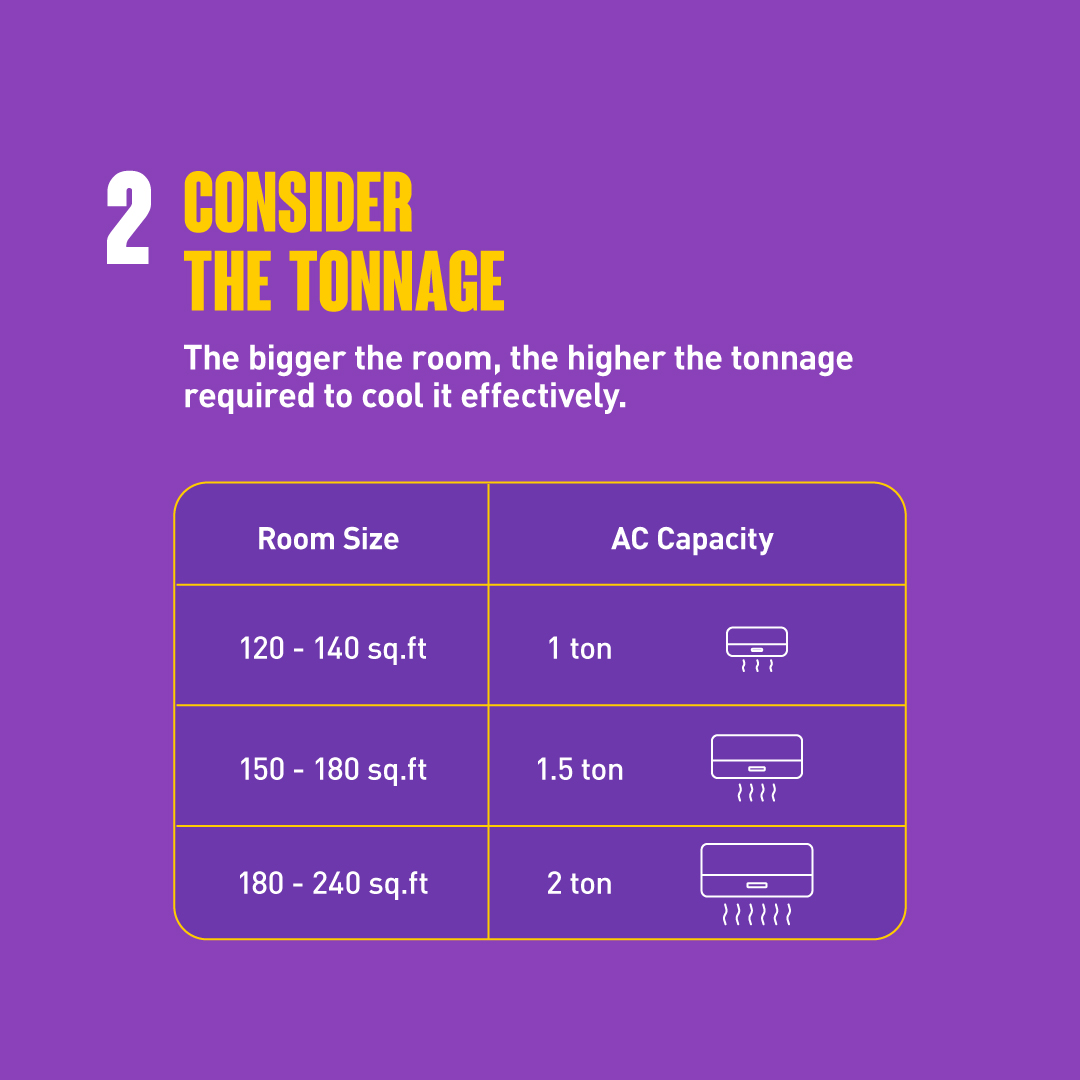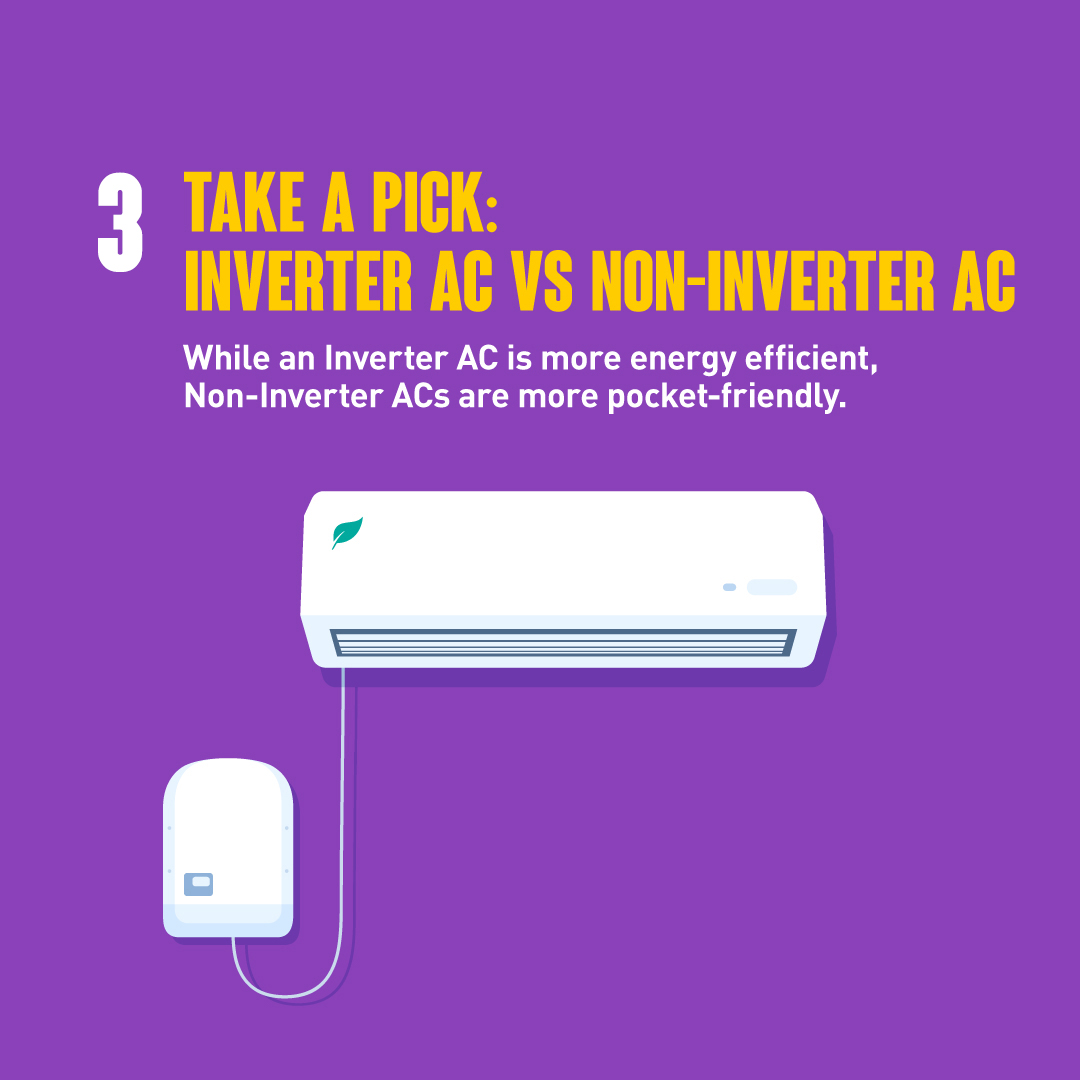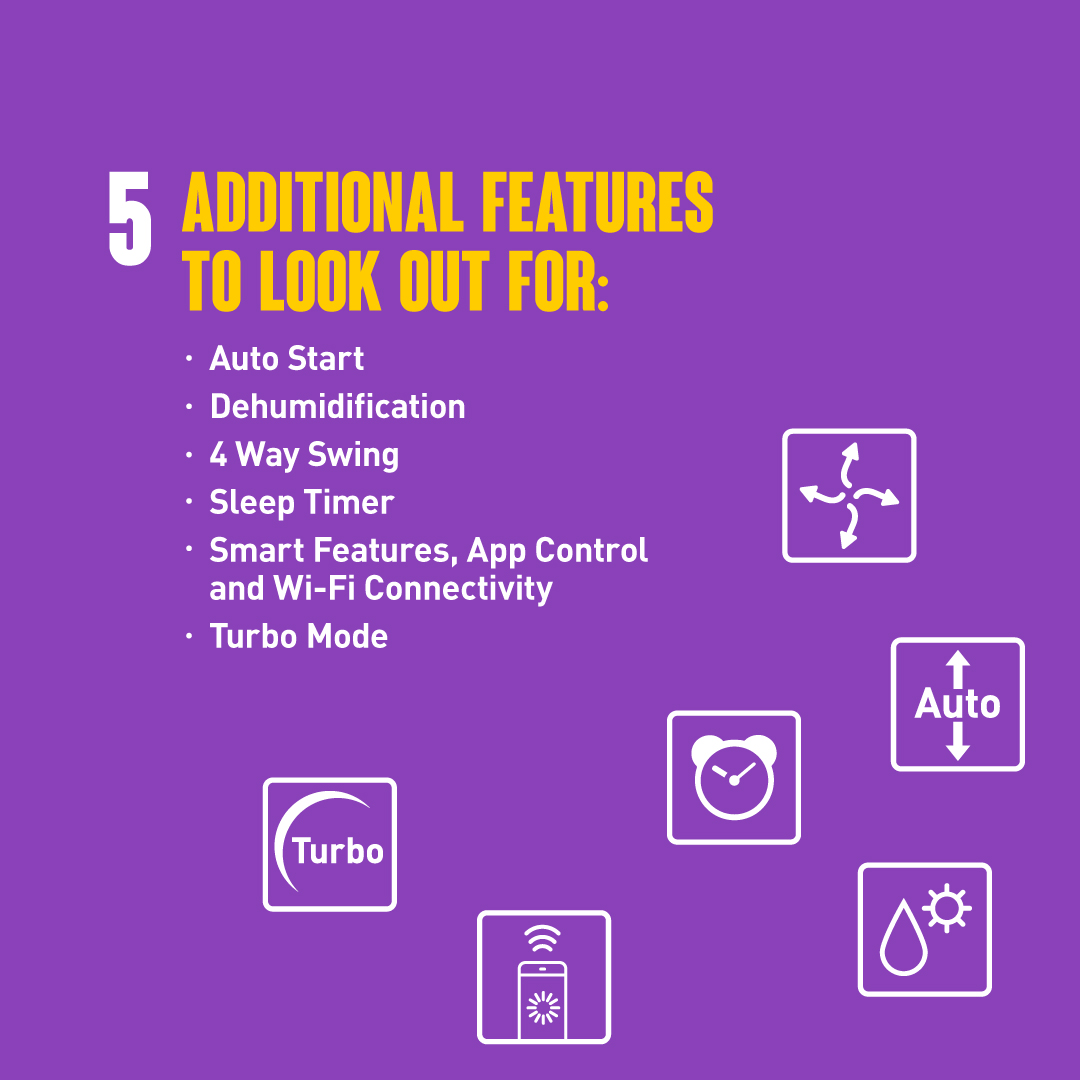Last Updated on July 25, 2024 by Vignesh
An AC (Air Conditioner) has become a necessity these days, especially for those who live in hot and humid areas. If you’re looking to buy a new AAC, it is a better idea to not wait until summer as you can get better deals in winter. The process of buying a new AC can be quite confusing and cumbersome as there are multiple brands and multiple types of ACs to consider. On top of that, every company markets specific AC features in their own way, making it harder to understand them and compare them in an apples-to-apples way.
Our AC buying guide should make the whole process easier. First, you need to decide your budget, then study which type of AC is suitable for your needs, and then calculate the AC’s cooling capacity that’s required for your room. You should also consider how frequently you would use the AC and look at their power efficiency ratings.
Which Type Of AC Is Suitable For Your Room?
There are three types of ACs: Split AC, Window AC, and Portable AC. Each one of these has its own advantages and disadvantages, and you should choose according to your needs and priorities.

1. Split AC
Split ACs feature two units: an indoor unit and an outdoor unit. The indoor unit features the blower and an evaporator (cooling coils), while the outdoor unit has the compressor and the condenser. Both units are connected via a pipe.
Although split ACs offer faster cooling and higher airflow, they are costlier to install and cumbersome to uninstall when it’s time to move to a new home. Moreover, there’s a limit as to how far the indoor and outdoor units can be: the farther they are, the less efficient the whole unit becomes. They are also costlier to maintain compared to other types of ACs.
| Advantages Of Split ACs | Disadvantages Of Split ACs |
|---|---|
| Faster Cooling For Larger Rooms | Costly |
| Low Noise | More Expensive To Maintain |
| Can Be Installed On Any Wall | |
| Aesthetically Pleasing |
2. Window AC
Window ACs (also known as Monoblock ACs) are relatively simpler compared to split ACs, and they don’t require as much space for installation. All the components are included in the same unit, so the installation and uninstallation of a window AC are much easier and cheaper. This means that if you live in a rented house and move frequently, a window AC might mean less hassle. However, they do not look as sophisticated as split ACs.
Such types of ACs also block the room’s window opening and are relatively noisier. They might also be not a great idea for very large-sized rooms.
| Advantages Of Window ACs | Disadvantages Of Window ACs |
|---|---|
| Relatively Affordable | Noisy |
| Easier To Install, Uninstall | Unsophisticated Design |
| Easy Relocation | Block Window View |
| Easier To Maintain | Not Ideal For Very Large Rooms |
| Ideal For Smaller Rooms |
3. Portable AC
Portable ACs are easier to move from one room to another. They are similar to window ACs, but they can be moved. Such ACs come with a hose that has one of its ends connected to the AC unit, while the other needs to be placed outside the window.
If you are someone who wants to cool the living room where you spend most of your day and your bedroom where you spend the night, but you don’t want to spend on two ACs, then a portable AC can prove to be a good choice. However, it has its own share of disadvantages, including higher noise and a slightly higher price. Moreover, they are good enough for smaller rooms.
| Advantages Of Portable ACs | Disadvantage Of Portable ACs |
|---|---|
| Portable, Easy To Move | Pricey |
| Suitable For Cooling Multiple Rooms | Noisy |
| Easy Installation | Messy |
What Is The Size Of Your Room & What AC Capacity Do You Need For Effective Cooling?

You need to calculate the size of the room that you are trying to cool, and then decide what the ideal AC capacity that is needed to cool the room effectively is. AC capacity is rated at tonnage in India, but the more accurate way to measure how fast an AC can cool a room is to see its BTU (British Thermal Unit) rating. The BTU rating is also used to measure the AC’s energy efficiency.
1KW/Hr = 3,412 BTU
12,000 BTU = 1 Ton
There are a lot of factors that can affect an AC’s cooling effectiveness: including the number of windows, number of heat sources, area exposed to the sun, the area of walls that are exposed to the sun from the outside, ceiling area exposed to the sun, and the number of people in the room. However, tonnage and BTU can ratings can be used to see if an AC can effectively cool a room.
The following table can be used to see what tonnage is effective for your room.
| Room Size | BTU | Tonnage |
|---|---|---|
| 100-120 sq. ft. | 6,000 BTU | 0.5 Ton |
| 120-150 sq. ft. | 9,000 BTU | 0.75 Ton |
| 150-180 sq. ft. | 12,000 BTU | 1.00 Ton |
| 180-250 sq. ft. | 18,000 BTU | 1.50 Ton |
| 300-350 sq. ft. | 24.000 BTU | 2.00 Ton |
| 350-500 sq. ft. | 36,000 BTU | 3.00 Ton |
Inverter vs. Non-Inverter AC: Which Is Better?

There are two types of ACs: inverter and non-inverter. Inverter ACs are usually more power-efficient, but they are also more expensive. There’s a common misconception that an inverter AC is meant to run on a power inverter (power backup), but that is absolutely wrong. This is the answer you’ll most likely get through salesmen in some retail stores.
The compressor of a non-inverter AC runs on full power until the room’s temperature reaches the desired temperature, and then it stops working. This start-stop procedure not only puts a sudden load on the power supply but also consumes more power. However, an inverter AC compressor runs all the time and continuously adjusts the power consumption according to the need. This is why inverter ACs are more power-efficient than non-inverter ACs. However, this functionality costs more money.
| Advantages Of Inverter AC | Advantages Of Non-Inverter AC |
|---|---|
| More Energy-Efficient | Cheaper Than Inverter ACs |
| Low Noise | |
| Cools Faster | |
| Longer Life |
What Is a Dual Inverter AC?
Unlike normal inverter ACs, which use a single-cylinder, single rotary compressor with variable speed, dual-inverter ACs use a more advanced version of BLDC motors that have twin rotators.
Due to the twin-rotator design, it produces a phase difference of 180 degrees, thereby making it easier to operate at a wider frequency range. Dual inverter ACs offer better cooling and higher energy efficiency compared to normal inverter ACs.
Energy Efficiency: What Are BEE’s EER & ISEER Ratings?

The energy efficiency rating (EER) of an AC is calculated and awarded by BEE (Bureau Of Energy Efficiency) in India. The rating agency has made it compulsory for heavy electrical appliances such as ACs to have an energy efficiency rating. The higher the rating, the higher the power efficiency, which means lower power consumption for cooling the room. However, ACs with higher ISEER ratings also cost more. Here’s how EER are ISEER are calculated:
EER = BTU/Hr / Watt
Since EER can change based on the season, ISEER was introduced by the BEE. Here’s how ISEER is calculated for ACs:
ISEER = Cooling Seasonal Total Load (CSTL) / Cooling Seasonal Energy Consumption (CSEC)
This value is then used to decide an AC’s ISEER rating. The ISEER rating is different for split ACs and window ACs. Moreover, values for ISEER ratings can change from time to time. Here are the current ISEER ratings and values:
| Window ACs | Split ACs | |||
|---|---|---|---|---|
| ISEER Star Level | Minimum ISEER | Maximum ISEER | Minimum ISEER | Maximum ISEER |
| 1 | 2.5 | 2.69 | 3.1 | 3.29 |
| 2 | 2.7 | 2.89 | 3.3 | 3.49 |
| 3 | 2.9 | 3.09 | 3.5 | 3.99 |
| 4 | 3.1 | 3.29 | 4 | 4.49 |
| 5 | 3.3 | 4.5 |
Also Read: Air Conditioner Energy-Saving Tips
Do You Require a Voltage Stabilizer for Your AC?
Almost all new ACs from most brands come with a built-in voltage stabilizer for protection from high and low voltages. However, even such ACs have an operational limit as to how much difference they can manage, and you need to check those ratings.
If your area usually faces extreme voltage fluctuations, you may need to buy a more potent voltage stabilizer.
How Important Are an AC’s Warranty & Service Quality?
The warranty period and service quality are crucial for any pricey device, including ACs. Most ACs come with a 1-year brand warranty and a longer warranty period for the compressor. Since the compressor is the most important part of any AC, its repair cost is higher, too. So, you must notice the warranty period that a brand is offering on the AC’s compressor.
Some brands offer as low as a three-year compressor warranty, while premium brands offer as high as a ten-year compressor warranty. The longer the warranty period, the better.

An AC also requires regular maintenance to keep it functioning efficiently, so it is a good idea to get an annual maintenance contract (AMC) plan from a trusted service provider. With Onsitego’s Comprehensive AMC plan, you can get up to two years of repair and maintenance support, including two preventive maintenance visits every year, unlimited repairs (including the charge for labour, service, and transport), free gas charging (if required), and the cost of spare parts. If anything goes wrong, you can be assured of quality service.
Apart from an AC’s warranty period, the quality of service is important, too. Some brands are better than others when it comes to service quality, customer satisfaction, and customer experience.
To know a brand’s service quality and customer experience, you should read customer reviews on online stores, forums, social media websites like Facebook and Twitter, the brand’s YouTube comments section, and even on websites like Quora. You should also consider talking to your friends and acquaintances about their experience with their AC’s brand when it comes to service quality and experience.
Also Read: Most Common AC Problems
Additional Features to Consider While Buying an AC
- Auto Start
- Dehumidification
- Four-Way Swing
- Sleep Timer
- Smart Features, App Control, and Wi-Fi Connectivity
- Turbo Mode

1. Auto Start
When there is a power outage, and then the power is back, some ACs do not restart by themselves. An AC with the Auto Start feature can restart itself after the power is back, and set the temperature to the level that you had set before the power outage happened.
2. Dehumidification
While all ACs control humidity levels while cooling a room, some ACs come with an additional dehumidification feature that reduces humidity in the room. This feature is important if you live in an area that has uncomfortably high humidity.
3. Four-Way Swing For Better Airflow Across The Room
Most ACs come with a two-way swing for dispersing air in the room. While it doesn’t make a huge difference when it comes to the AC’s effectiveness in cooling the room, it certainly improves the perception of cooling as air passes by you every few seconds. Some ACs come with a four-way swing, which means that they can disperse air horizontally and vertically, making it easier to adjust the AC’s airflow more accurately. This is an important feature to have if airflow to a particular spot in the room is important to you.
4. Sleep Timer
The sleep timer feature can be used to turn off the AC after a particular period of time, thereby decreasing power bills. It certainly reduces the hassle of waking up during the night and turning the AC off.
5. Smart Features, App Control, and Wi-Fi Connectivity
Some premium ACs have smart features these days, including Wi-Fi (or Bluetooth) connectivity. These features allow ACs to be connected to your smartphone or online service, which can be used to control the AC when you are not in the room or even if you are not home. You can even control the AC using voice commands via your smartphone or smart speaker’s voice assistant (Alexa, Google Assistant, or Siri).
You can also set the AC to turn on automatically when certain conditions are met. For example, you can set the AC to turn on when you head home so that the room is already at your desired temperature by the time you reach home. However, such features vary depending on the brand and price category.
If you want your new AC to have such smart features, prefer models that are compatible with Alexa, Google Assistant, or HomeKit, and they should have a companion smartphone app for both Android and iOS.
6. Turbo Mode
Most brands have a different marketing name for this feature. Turning on this feature makes the AC run at full power to cool the room faster, but it also consumes higher power. However, you might need to use it once in a while.
AC Gimmicks To Stay Away From
1. Mosquito Repellent Feature
Some brands market their ACs to have a feature that repels mosquitoes. In markets like India, where there are more mosquitos, you can get attracted to this feature. However, this feature has proven to be ineffective, so don’t buy an AC just because it claims to have a mosquito-repellent feature.
2. Triple Inverter AC
Dual inverter ACs have 180-degree phase-shift compressors, making them operate at a wider range of frequencies and make them work in a more balanced manner. Similarly, you might think that a triple inverter AC would be better than a dual inverter AC, but the triple rotary makes the compressor relatively imbalanced.
3. Anti-Bacteria or COVID-19 Virus Filtration Claims
Some brands claim that the filters used in their ACs remove harmful bacteria. During this pandemic, some companies might even claim that AC filters are capable of filtering out the COVID-19 virus. However, it’s hard to judge the effectiveness of such features as testing them practically is not possible by most consumers. So, don’t choose an AC based on this feat.
Also Read: How To Keep Your Home Safe During COVID-19
So, these are all the important features that you should consider. When you go out (or browse online) to buy a new AC this year, make sure you choose an AC that suits your needs and fits your budget. You might need to make certain decisions to choose the right AC at the right price.


Discussion about this post